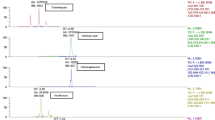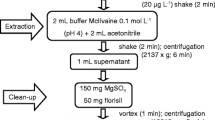Abstract
Honey residue and contaminant assessments are extremely important, as they deal with food and therapeutic safety issues of a widely consumed animal product. Pyrrolizidine alkaloids are secondary plant metabolites used by bees in honey production. The toxicity of these alkaloids has been discussed in the literature and health risks have been noted, due to their occurrence in both honey and in pyrrolizidine alkaloid-producing plants. Quinolones comprise a class of antimicrobials associated with hypersensitivity reactions and bacterial resistance, one of the world's most significant public health problems. In this context, the aim of this study was to evaluate the simultaneous presence of pyrrolizidine alkaloids and quinolones in different honey types. A simple and novel analytical method employing liquid chromatography coupled to high-resolution mass spectrometry using a quadrupole-time-of-flight hybrid analyzer (Q-TOF) was developed and validated. No quinolone residues were detected in 80 honey samples, while pyrrolizidine alkaloids were found in 49% of the investigated samples.


Similar content being viewed by others
References
R. Krell, Value-added Products from Beekee**. Food and Agriculture Organization of the United Nations (1996).
SINDAN SN de PV, Compêndio de Produtos Veterinários (2020). https://sistemas.sindan.org.br/cpvs/pesquisar.aspx. Accessed 30 May 2020
W. Reybroeck, E. Daeseleire, H.F. De Brabander, L. Herman, Antimicrobials in beekee**. Vet. Microbiol. 158, 1–11 (2012). https://doi.org/10.1016/j.vetmic.2012.01.012
European Commission, RASFF portal (2019a).
WHO/AGISAR WHO-AG on IS of AR, Critically important antimicrobials for human medicine: ranking of antimicrobial agents for risk management of antimicrobial resistance due to non-human use (2017).
World Organization for Animal Health, OIE list of antimicrobial agents of veterinary importance (2018).
J.A. Edgar, S.M. Colegate, M. Boppre, R.J. Molyneux, Pyrrolizidine alkaloids in food: a spectrum of potential health consequences. Food Addit. Contam. Part A 28, 308–324 (2011). https://doi.org/10.1080/19440049.2010.547520
R. Michel, K.-P. Raezke, Pyrrolizidine Alkaloids in Honey—Brief Overview Regarding de Occurrence, Toxicological Effects and Risk Assessment. Bremen, Germany (2009).
IARC-WHO, IARC monographs on the evaluation of carcinogenic risk of chemicals to Man. Volume 10: some naturally occurring substances, Volume 11: cadmium, nickel, some epoxides, miscellaneous industrial chemicals and general considerations on volatile anaesthetics (1977). http://www.ncbi.nlm.nih.gov/pmc/articles/PMC476386/
JECFA, Technical report series (954): evaluation of certain veterinary drug residues in food : seventieth report of the Joint FAO/WHO Expert Committee on Food Additives. World Health Organization (2009).
Codex Alimentarius, Maximum residue limits for veterinary drugs in foods (2012).
MAPA, Instrução Normativa número 05 de 23 de Abril de 2019 - Plano de amostragem e limites de referência para o Plano Nacional de Controle de Resíduos e Contaminantes em Produtos de Origem Animal - PNCRC (2019).
Community Reference Laboratories, CRLs view on state of the art analytical methdos for national residue control plans (2007).
MHLW, Department of Environmental Health and Food Safety Pharmaceutical Safety and Environmental Health Bureau-Ministry of Health, Labour and Welfare (2018). Measures to ensure food safety. http://www.mhlw.go.jp/english/policy/health-medical/food/dl/pamphlet.pdf. Accessed 7 May 2018
Conselho da União Europeia, Decisão da Comissão 2002/657/CE - DECISÃO DA COMISSÃO de 12 de Agosto de 2002 que dá execução ao disposto na Directiva 96/23/CE do Conselho relativamente ao desempenho de métodos analíticos e à interpretação de resultados (2002).
CAC/GL 71-2009, Guidelines for the design and implementation of national regulatory food safety assurance programme associated with the use of veterinary drugs in food producing animals (2009).
M.C. Pereira, W.F. Magalhães, Manual de Garantia da Qualidade Analítica–Resíduos e Contaminantes em Alimentos. Ministério da Agricultura Pecuária e Abastecimento. Secretaria de Defesa (2011).
FDA, Preparation and LC-MS/MS Analysis of Honey for Fluoroquinolones Residues (2006).
Codex Alimentarius, Guidelines on performance criteria for methods of analysis for the determination of pesticide residues in food and feed. CAC/GL 90-2017 (2017).
European Commission, SANTE/12682/2019—guidance document on analytical quality control and method validation procedures for pesticides residues analysis in food and feed (2019b).
W. Du, J. Yao, Y. Li, Y. Hashi, Rapid determination of residual quinolones in honey samples by fast HPLC with an on-line sample pretreatment system. Am. J. Anal. Chem. 02, 200–205 (2011). https://doi.org/10.4236/ajac.2011.22023
H.G.J. Mol, P. Plaza-Bolanos, P. Zomer, et al., Toward a generic extraction method for simultaneous determination of pesticides, mycotoxins, plant toxins, and veterinary drugs in feed and food matrixes. Anal. Chem. (2008).
R. Venable, C. Haynes, J.M. Cook, Reported prevalence and quantitative LC-MS methods for the analysis of veterinary drug residues in honey: a review. Food Addit. Contam. Part A 31, 621–640 (2014). https://doi.org/10.1080/19440049.2014.886339
D. Bodi, S. Ronczka, C. Gottschalk et al., Determination of pyrrolizidine alkaloids in tea, herbal drugs and honey. Food Addit. Contam. Part A 31, 1886–1895 (2014). https://doi.org/10.1080/19440049.2014.964337
BrF, Determination of pyrrolizidine alkaloids (PA) in honey by SPE-LC-MS/MS (2013).
C.T. Griffin, J. O’Mahony, M. Danaher, A. Furey, Liquid chromatography tandem mass spectrometry detection of targeted pyrrolizidine alkaloids in honeys purchased within Ireland. Food Anal. Methods 8, 18–31 (2015). https://doi.org/10.1007/s12161-014-9855-1
A.C. Valese, L. Molognoni, L.A. de Sá Ploêncio et al., A fast and simple LC-ESI-MS/MS method for detecting pyrrolizidine alkaloids in honey with full validation and measurement uncertainty. Food Control 67, 183–191 (2016). https://doi.org/10.1016/j.foodcont.2016.02.050
P.P. Mulder, S.L. de Witte, G.M. Stoopen et al., Transfer of pyrrolizidine alkaloids from various herbs to eggs and meat in laying hens. Food Addit. Contam. Part A 33, 1826–1839 (2016). https://doi.org/10.1080/19440049.2016.1241430
S. Zhou, K.D. Cook, Protonation in electrospray mass spectrometry: wrong-way-round or right-way-round? J. Am. Soc. Mass Spectrom. 11, 961–966 (2000). https://doi.org/10.1016/S1044-0305(00)00174-4
J.B.M. Libarondi, Comparing the capabilities of time-of-flight and quadrupole mass spectrometers (2017). http://www.chromatographyonline.com/comparing-capabilities-time-flight-and-quadrupole-mass-spectrometers-0?id=&sk=&date=&pageID=3. Accessed 2 Nov 2017
I.V. Chernushevich, A.V. Loboda, B.A. Thomson, An introduction to quadrupole–time-of-flight mass spectrometry. J. Mass Spectrom. 36, 849–865 (2001). https://doi.org/10.1002/jms.207
M. Badertscher, K. Bischofberger, M.E. Munk, E. Pretsch, A novel formalism to characterize the degree of unsaturation of organic molecules. J. Chem. Inf. Comput. Sci. 41, 889–893 (2001). https://doi.org/10.1021/ci000135o
University of Sydney, Degree of unsaturation calculator (2019). https://scilearn.sydney.edu.au/fychemistry/calculators/degree_of_unsaturation.shtml. Accessed 4 Mar 2019
M.L. Gomez-Perez, P. Plaza-Bolanos, R. Romero-Gonzalez et al., Comprehensive qualitative and quantitative determination of pesticides and veterinary drugs in honey using liquid chromatography-Orbitrap high resolution mass spectrometry. J. Chromatogr. A 1248, 130–138 (2012). https://doi.org/10.1016/j.chroma.2012.05.088
H.G.J. Mol, R.C.J. Van Dam, P. Zomer, P.P.J. Mulder, Screening of plant toxins in food, feed and botanicals using full-scan high-resolution (Orbitrap) mass spectrometry. Food Addit. Contam. Part A 28, 1405–1423 (2011). https://doi.org/10.1080/19440049.2011.603704
P. Pérez-Ortega, F.J. Lara-Ortega, B. Gilbert-López et al., Screeningof over 600 pesticides, veterinarydrugs, food-packagingcontaminants, mycotoxins, and other chemicals in food by ultra-high performance liquidchromatographyquadrupole time-of-flight mass spectrometry (UHPLC-QTOFMS). Food Anal. Methods 10, 1216–1244 (2017). https://doi.org/10.1007/s12161-016-0678-0
Acknowledgements
The authors thank the fiocruz Analytical Methods Technology Platform Network.
Funding
This work was carried out with the support of the Higher Education Personnel Improvement Coordination - Brazil (CAPES) - Financing Code 001.
Author information
Authors and Affiliations
Corresponding author
Ethics declarations
Conflict of interest
The authors declare that they have no conflicts of interests.
Ethical approval
Ethical approval not applicable as no research involving animals, human participants, their data or biological material is described in this manuscript.
Additional information
Publisher's Note
Springer Nature remains neutral with regard to jurisdictional claims in published maps and institutional affiliations.
Supplementary Information
Below is the link to the electronic supplementary material.
Rights and permissions
About this article
Cite this article
Bandini, T.B., Spisso, B.F. Development and validation of an LC-HRMS method for the determination of pyrrolizidine alkaloids and quinolones in honey employing a simple alkaline sample dilution. Food Measure 15, 4758–4770 (2021). https://doi.org/10.1007/s11694-021-01048-9
Received:
Accepted:
Published:
Issue Date:
DOI: https://doi.org/10.1007/s11694-021-01048-9




